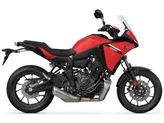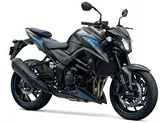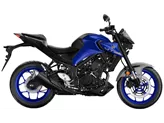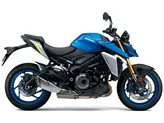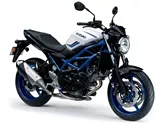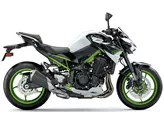Yamaha MT-07 2014 vs. Suzuki GSX-S750 2017

Yamaha MT-07 2014

Suzuki GSX-S750 2017
Overview - Yamaha MT-07 2014 vs Suzuki GSX-S750 2017
The Yamaha MT-07 2014 and the Suzuki GSX-S750 2017 are both naked bikes with similar engine types, liquid cooling, and front and rear tire dimensions. However, there are several key differences between the two models.
In terms of engine power, the Suzuki GSX-S750 2017 outperforms the Yamaha MT-07 2014 with 114 HP compared to 75 HP. The Suzuki also has a higher torque of 81 Nm compared to 68 Nm for the Yamaha. This means that the Suzuki offers more power and acceleration, making it a better choice for riders who enjoy a more thrilling and dynamic riding experience.
Another difference is the number of cylinders. The Yamaha MT-07 2014 has a 2-cylinder engine, while the Suzuki GSX-S750 2017 has a 4-cylinder engine. The additional cylinders in the Suzuki contribute to its higher power output and smoother performance.
The chassis of the two bikes also differs. The Yamaha MT-07 2014 has a steel frame, while the Suzuki GSX-S750 2017 features an aluminum frame. The aluminum frame of the Suzuki provides a lighter weight and improved agility, making it easier to handle and maneuver.

Yamaha MT-07 2014
In terms of suspension, the Yamaha MT-07 2014 has a telescopic fork front suspension, while the Suzuki GSX-S750 2017 features an upside-down telescopic fork. The upside-down fork in the Suzuki provides better suspension control and improved handling, especially during aggressive riding.
Both bikes have double disk front brakes, offering powerful and reliable stopping power. However, the Suzuki GSX-S750 2017 is heavier, with a kerb weight of 213 kg compared to 179 kg for the Yamaha MT-07 2014. This additional weight may affect the braking performance and overall handling of the Suzuki.
In terms of dimensions, the Suzuki GSX-S750 2017 has a longer wheelbase of 1455 mm compared to 1400 mm for the Yamaha MT-07 2014. This longer wheelbase contributes to the stability and straight-line performance of the Suzuki.

Suzuki GSX-S750 2017
The seat height of the Suzuki GSX-S750 2017 is also slightly higher at 820 mm compared to 805 mm for the Yamaha MT-07 2014. This may affect the comfort and accessibility for shorter riders.
In terms of weaknesses, the Yamaha MT-07 2014 has a suspension that is considered a little soft, which may affect the overall handling and stability of the bike. Additionally, the footrests on the Yamaha tend to drag quickly, especially during aggressive cornering. The Yamaha also has some cheap plastic parts, which may affect the overall durability and quality of the bike. The telescopic fork on the Yamaha is also considered boring, lacking the advanced suspension technology found in the upside-down fork of the Suzuki.
On the other hand, the Suzuki GSX-S750 2017 has an acute knee angle, which may cause discomfort for taller riders. The tachometer on the Suzuki is also difficult to read, which may be inconvenient for riders who rely on accurate RPM readings.
In conclusion, the Yamaha MT-07 2014 and the Suzuki GSX-S750 2017 are both capable naked bikes with their own strengths and weaknesses. The Yamaha offers light handling, a comfortable seating position, and a throaty sound, while the Suzuki provides a more powerful engine, well-controlled brakes, and a harmonious design. Ultimately, the choice between the two models will depend on the rider's preferences and priorities.
Technical Specifications Yamaha MT-07 2014 compared to Suzuki GSX-S750 2017
Pros and Cons in comparison
Pros and Cons in comparison
Yamaha MT-07 2014

The MT-07 is an incredible fun machine that is extremely sporty to ride. The brakes pack a punch, the handling is superb and the engine is currently by far the most agile powerplant in this class - and even above.
Suzuki GSX-S750 2017

More power, more performance, more sound. Suzuki also proves all the pessimists regarding the EURO4 standard wrong and delivers the GSX-S 750, a successor to the GSR 750 that has been further developed in every respect and can be a bit more serious, but doesn't have to be. To ensure that aha moments don't become oje moments, ABS and a three-stage traction control that can be switched off provide a safety cushion. With S21 tyres from Bridgestone, the GSX-S is super-sporty, allowing you to take advantage of the generous lean angle clearance. Only the acute knee angle could be a disadvantage on longer tours.
Price Comparison Avarage Market Price Yamaha MT-07 vs Suzuki GSX-S750
There are a few key differences between a Yamaha MT-07 2014 and a Suzuki GSX-S750 2017. In terms of price, the actual average price of a Suzuki GSX-S750 2017 is about 33% higher. Compared to Suzuki GSX-S750 2017 there are more Yamaha MT-07 2014 bikes available on the 1000PS.de Marketplace, specifically 17 compared to 14. It takes less time to sell a Yamaha MT-07 with 37 days compared to 84 days for a Suzuki GSX-S750. Since model year 2013 1000PS.de editors have written 69 reviews for the Yamaha MT-07 and 14 reviews for the Suzuki GSX-S750 since model year 2017. The first review for the Yamaha MT-07 was published on 04/11/2013 and now has more than 12,600 views. This compares to more than 50,800 views for the first review on Suzuki GSX-S750 published on 04/10/2016.




